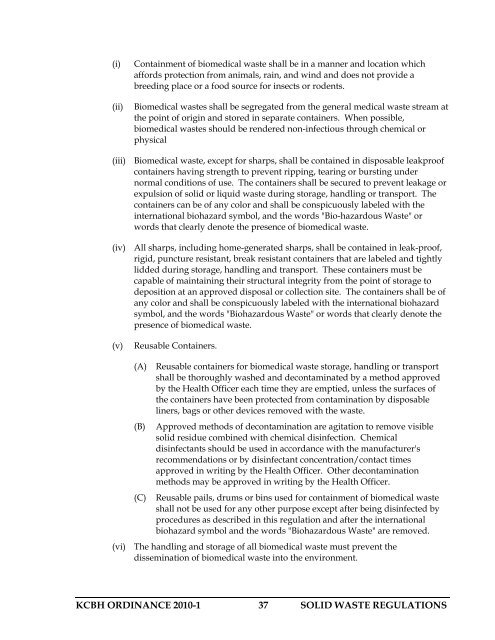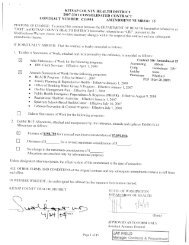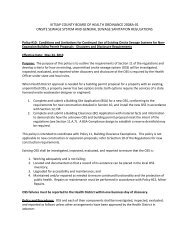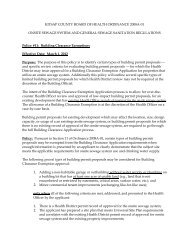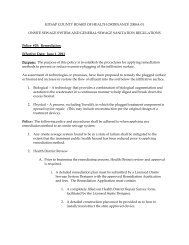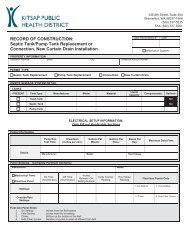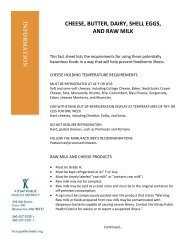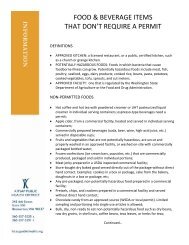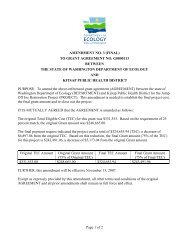SOLID WASTE REGULATIONS - Kitsap Public Health District
SOLID WASTE REGULATIONS - Kitsap Public Health District
SOLID WASTE REGULATIONS - Kitsap Public Health District
You also want an ePaper? Increase the reach of your titles
YUMPU automatically turns print PDFs into web optimized ePapers that Google loves.
(i)<br />
(ii)<br />
Containment of biomedical waste shall be in a manner and location which<br />
affords protection from animals, rain, and wind and does not provide a<br />
breeding place or a food source for insects or rodents.<br />
Biomedical wastes shall be segregated from the general medical waste stream at<br />
the point of origin and stored in separate containers. When possible,<br />
biomedical wastes should be rendered non-infectious through chemical or<br />
physical<br />
(iii) Biomedical waste, except for sharps, shall be contained in disposable leakproof<br />
containers having strength to prevent ripping, tearing or bursting under<br />
normal conditions of use. The containers shall be secured to prevent leakage or<br />
expulsion of solid or liquid waste during storage, handling or transport. The<br />
containers can be of any color and shall be conspicuously labeled with the<br />
international biohazard symbol, and the words "Bio-hazardous Waste" or<br />
words that clearly denote the presence of biomedical waste.<br />
(iv) All sharps, including home-generated sharps, shall be contained in leak-proof,<br />
rigid, puncture resistant, break resistant containers that are labeled and tightly<br />
lidded during storage, handling and transport. These containers must be<br />
capable of maintaining their structural integrity from the point of storage to<br />
deposition at an approved disposal or collection site. The containers shall be of<br />
any color and shall be conspicuously labeled with the international biohazard<br />
symbol, and the words "Biohazardous Waste" or words that clearly denote the<br />
presence of biomedical waste.<br />
(v)<br />
Reusable Containers.<br />
(A) Reusable containers for biomedical waste storage, handling or transport<br />
shall be thoroughly washed and decontaminated by a method approved<br />
by the <strong>Health</strong> Officer each time they are emptied, unless the surfaces of<br />
the containers have been protected from contamination by disposable<br />
liners, bags or other devices removed with the waste.<br />
(B)<br />
(C)<br />
Approved methods of decontamination are agitation to remove visible<br />
solid residue combined with chemical disinfection. Chemical<br />
disinfectants should be used in accordance with the manufacturer's<br />
recommendations or by disinfectant concentration/contact times<br />
approved in writing by the <strong>Health</strong> Officer. Other decontamination<br />
methods may be approved in writing by the <strong>Health</strong> Officer.<br />
Reusable pails, drums or bins used for containment of biomedical waste<br />
shall not be used for any other purpose except after being disinfected by<br />
procedures as described in this regulation and after the international<br />
biohazard symbol and the words "Biohazardous Waste" are removed.<br />
(vi) The handling and storage of all biomedical waste must prevent the<br />
dissemination of biomedical waste into the environment.<br />
KCBH ORDINANCE 2010-1 37 <strong>SOLID</strong> <strong>WASTE</strong> <strong>REGULATIONS</strong>


